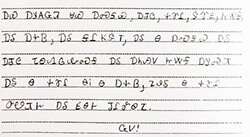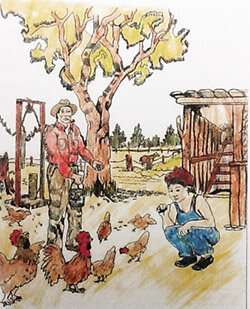Study finds students learning Cherokee writing developed previously unknown, 'idiosyncratic' style

Cherokee is spoken as a first language by fewer than 5,000 people, yet in recent years it has experienced a remarkable revival as a second language. But what happens when entire generations may have learned to speak the language but not read or write it? Research from the University of Kansas shows children learning to write Cherokee in an Oklahoma immersion school internalized both English and Cherokee to develop an idiosyncratic writing style.
KU researchers Lizette Peter and Tracy Hirata-Edds have worked with Tsalagi Dideloquasdi, a Cherokee immersion school in Tahlequah, Oklahoma, for several years to learn more about the revitalization of the language and how students acquire Cherokee. The recent findings are among the first studies to examine writing in the language, and the researchers found the students developed their own style of writing never seen in the language. Peter and Hirata-Edds argue it is not bad or incorrect, and it gives teachers important information to develop new approaches to help learners continue to build their bilingual skills.
"We didn't know what to expect regarding how proficient their writing would be," said Peter, associate professor of curriculum & teaching. "Oral language is different because you have an interlocutor, in the schools' case, a teacher. When writing, the students have to rely on all they know about both Cherokee and English."
Cherokee uses an orthography known as syllabary in its written form. Developed by Cherokee folk hero Sequoyah in the 1820s, it is unique among American Indian languages. The written form has many differences from English; for example, it does not use articles such as "a," "an" or "the" before nouns, and it synthesizes morphemes to a much higher degree than English. However, when analyzing students' writing samples and comparing them to samples of oral stories by Cherokee adults, the students often used grammatical conventions characteristic of English, such as creating an article where none was required.
"We found the repurposing of a Cherokee demonstrative adjective peppered throughout their writing before every noun, the way an article is used in English," Peter said. "Cherokee is a highly synthetic language, so articles are generally fused with the noun. The children clearly felt the need for a separate article, though, the way their English rules tell them it should be. We're challenging the notion that they write 'bad Cherokee.' Instead, we see them as having a need to convey an idea and they're doing it in their bilingual way, through translanguaging."

The findings comprise a chapter in the book "Teaching Writing to Children in Indigenous Languages: Instructional Practices from Global Contexts," edited by Ari Sherris and Joy Peyton. The chapter was written by Peter; Tracy Hirata-Edds, lecturer in KU's Applied English Center, and Ryan Wahde Mackey of Cherokee Nation.
Most people who speak Cherokee as their first language are of the grandparent generation. Most speakers of younger generations never learned to read or write the language. So, today's students had little prior exposure to written Cherokee. For example, children's literature in Cherokee was almost nonexistent when the immersion school began, so unlike many children, students did not have access to stories in their written language. Fortunately, there has been a lot of documentation of Cherokee stories. Brad Montgomery-Anderson, who received his doctorate in linguistics from KU in 2008, recorded, transcribed and analyzed oral stories told by expert Cherokee speakers, and the researchers compared those stories with the ones written by the immersion school students.
"We used a lot of different lenses to study the writing," Peter said. "We couldn't understand children's writing without also looking at what was going on in the school and then, examining more broadly their families' and communities' experiences with Cherokee language contact, shift and revitalization from a historical perspective. So, we try to contextualize their writing within the many levels of speakerhood that characterize the Tahlequah, Oklahoma, community."
The chapter includes pedagogical solutions to assist teachers. They suggest supplementing the immersion approach, in which Cherokee is the only language spoken, with a focus on linguistic forms. As the students are bilingual, teachers can use that to their advantage. It is admittedly a fine balance, the authors write, but an approach comparing and contrasting the languages can help illustrate the rules of writing in both, how they differ and why. That way, instead of just pointing out students' errors, teachers can help them develop metalinguistic awareness and an understanding of why each language has the rules it does. By helping teachers, researchers can in turn help students who will be the future speakers and writers of the language.
"As applied linguists, we think about oracy and literacy and how they tie together and represent the identity of those speakers, especially as they learn to express themselves in indigenous languages, many of which are threatened," Peter said. "The idiosyncrasies we see in their writing are a testament to the creativity of the human mind and how language is a key outlet for that creativity."
Provided by University of Kansas




















